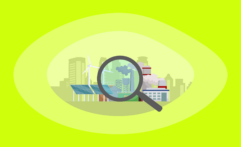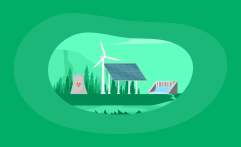Coal Energy Explained: All You Need to Know
Impactful Ninja is reader-supported. When you buy through links on our site, we may earn an affiliate commission.
Learn more
Learn more
.
Hey fellow impactful ninja ? You may have noticed that Impactful Ninja is all about providing helpful information to make a positive impact on the world and society. And that we love to link back to where we found all the information for each of our posts. Most of these links are informational-based for you to check out their primary sources with one click. But some of these links are so-called "affiliate links" to products that we recommend. First and foremost, because we believe that they add value to you. For example, when we wrote a post about the environmental impact of long showers, we came across an EPA recommendation to use WaterSense showerheads. So we linked to where you can find them. Or, for many of our posts, we also link to our favorite books on that topic so that you can get a much more holistic overview than one single blog post could provide. And when there is an affiliate program for these products, we sign up for it. For example, as Amazon Associates, we earn from qualifying purchases. First, and most importantly, we still only recommend products that we believe add value for you. When you buy something through one of our affiliate links, we may earn a small commission - but at no additional costs to you. And when you buy something through a link that is not an affiliate link, we won’t receive any commission but we’ll still be happy to have helped you. When we find products that we believe add value to you and the seller has an affiliate program, we sign up for it. When you buy something through one of our affiliate links, we may earn a small commission (at no extra costs to you). And at this point in time, all money is reinvested in sharing the most helpful content with you. This includes all operating costs for running this site and the content creation itself. You may have noticed by the way Impactful Ninja is operated that money is not the driving factor behind it. It is a passion project of mine and I love to share helpful information with you to make a positive impact on the world and society. However, it's a project in that I invest a lot of time and also quite some money. Eventually, my dream is to one day turn this passion project into my full-time job and provide even more helpful information. But that's still a long time to go. Stay impactful,Affiliate Disclosure
Why do we add these product links?
What do these affiliate links mean for you?
What do these affiliate links mean for us?
What does this mean for me personally?
![]()
Coal has been and still is our largest source of electricity generation. But it is also our largest single source of carbon dioxide (CO2) emissions, which wreaks havoc on our environment. So, we had to ask: What is coal energy really, and how does it contribute to climate change?
Coal energy is created when coal is combusted in coal-fired power plants. Per kWh produced, coal energy emits 820 grams of CO2 on a life-cycle basis. It contributes to climate change and produces toxic waste products that degrade the planet.
Keep reading to find out all about what coal energy is, its global capacity, its carbon footprint, its environmental benefits and drawbacks, and how it can contribute to climate change.
The Big Picture of Coal Energy
Coal is one of the most important primary fossil fuels used for domestic energy generation and overseas transport. It is one of the cheapest for its energy content but also contributes to climate change via the release of greenhouse gas emissions (GHGs) upon combustion.
How Is Coal Energy Defined
Coal is one of the three main fossil fuels (coal, oil, and natural gas). It is formed when plant and animal remains gradually build up on the earth’s surface and the ocean floor, mixing with sand, silt, and calcium carbonate. Under immense heat and pressure, some of these remains are converted into coal.
“Coal: a combustible black or dark brown rock consisting mainly of carbonized plant matter, found mainly in underground deposits and widely used as fuel.”
Cambridge Dictionary
Coal energy is produced via the combustion of these pressurized plant and animal remains. The heat created upon combustion creates steam which spins a turbine and spins a generator to produce electricity.
What Are the Different Types of Coal Energy
Not all coal is the same. In fact, there are 4 main types, or ranks, of coal depending on the type and amount of carbon the coal contains and the amount of heat energy the coal can produce:
- Anthracite: The highest rank of coal. A hard, brittle, and black lustrous coal that is often referred to as hard coal because it contains the highest concentration of coal (86-97%) out of all coal ranks.
- Bituminous: A middle rank of coal. It has a 45-65% carbon content and is typically used for electricity generation and steel making because it has a high heating (Btu) value.
- Subbituminous: A middle rank of coal. It has a 35-45% carbon content and is typically used in electricity generation because it has a low-to-moderate heating value.
- Lignite: The lowest grade of coal, also referred to as brown coal. It contains the least concentration of carbon (25-35%), has a high moisture concentration, has a low heating value, and is typically used in electricity generation.
Bituminous coal is produced the most, followed by subbituminous, lignite, and lastly anthracite.

Coal energy contributes directly to climate change, so let’s have a closer look at it next.
| What coal energy is | Coal energy is produced via the combustion of black or brownish-black sedimentary rock containing energy stored by plants that lived in swampy forests over a hundred million years ago. |
| What the different types coal energy are | The four ranks of coal are anthracite, bituminous, subbituminous, and lignite. |
| How coal energy works | Coal energy works by combusting coal in a power plant. This generates heat which turns water into steam, rotates turbines, and drives generators to produce electricity. |
| The global capacity of coal energy | Coal is a finite resource, and if we continue to use it at our current rate we can expect to run out of coal in approximately 100 years. |
| The carbon footprint of coal energy | On a life-cycle basis, coal emits 820 grams of carbon dioxide (CO2) equivalent per kWh of electricity produced. |
| The environmental benefits of coal energy | Although coal does not benefit the environment, there are various methods to possibly mitigate its environmental impact. |
| The environmental drawbacks of coal energy | Burning coal adds to the total level of CO2 in our atmosphere and expedites global warming. It also causes air and water pollution and creates toxic waste products which can leach into the environment. |
| Coal energy and climate change | Coal energy contributes to climate change by exacerbating temperature rise, sea-level rise, ice melting, and ocean acidification. |
How Does Coal Energy Work
In general, coal energy works by combusting coal in coal-fired power plants to produce steam which turns a turbine and spins a generator to produce electricity.
How Does Coal Energy Actually Produce Energy
The process of generating coal energy begins with mining the coal, constructing the power plant, and transporting the coal from the mines to the power plant.
- Mining: The mining industry generates between 1.9 billion and 5.1 billion tons of CO2 annually, with an additional 400 million tons coming from power consumption.
- Construction: A coal-fired power plant has many components, including boiler rooms, smokestacks, cooling towers, generators, and turbines.
- Transportation: Coal is typically transported from mines to power plants by rail, river barge, or truck.
Once the coal is mined and transported to a coal-fired power plant, it can be converted into energy via the following process:
- Coal is mined into a fine powder before being blown into the combustion chamber of a boiler, where it is incinerated.
- The hot gases and heat energy convert water into steam.
- The steam is then passed into a turbine where it rotates the blades at a high speed.
- The blades then turn a generator which generates the electricity.
- Once the steam passes through the turbine it is condensed back into water and returned to the boiler chamber to be re-heated.

Coal plants have had a historical life expectancy of 46 years, but they can remain in operation from anywhere between 50 and 60 years.
What Is the Global Capacity of Coal Energy
Fossil fuel consumption began with the Industrial Revolution, and consumption has increased exponentially over the past 70 years. The type of fuel we consume has shifted from solely coal, to coal and oil, and lastly to coal, oil, and NG.
China is the world’s largest coal producer, consumer, and importer of coal. There are over 1,100 operational coal-fired power plants in China that account for for over 50% of global coal production and nearly 1/3rd of global coal consumption.
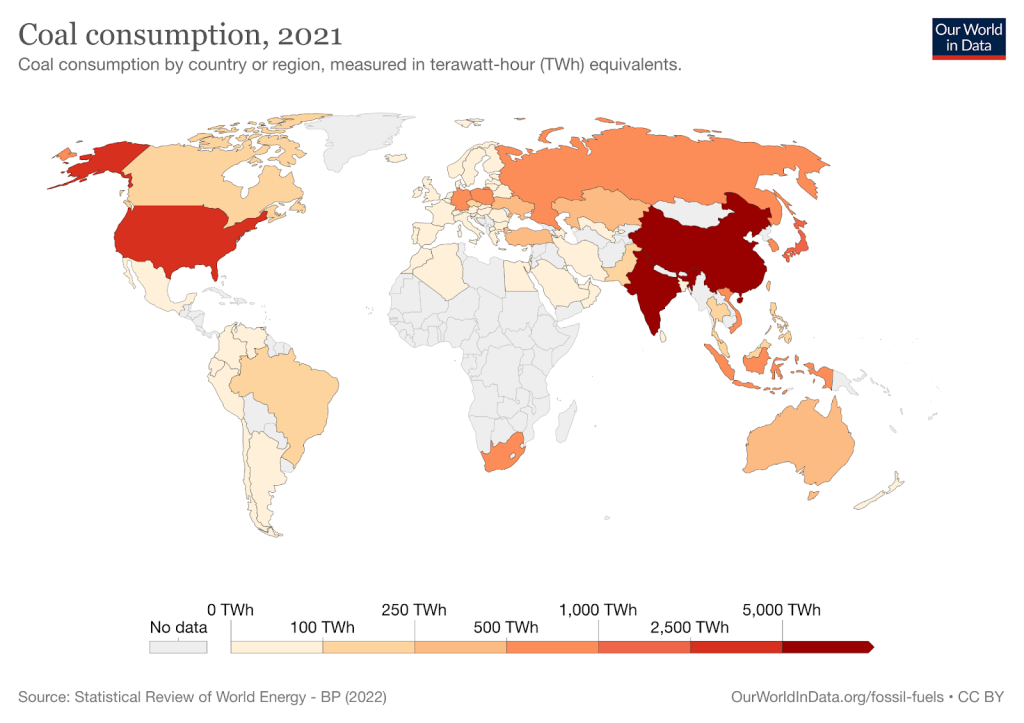
The COVID-19 pandemic caused a temporary 4.8% decrease in global coal consumption. However, consumption rebounded 6.3% in 2021 and is predicted to return to all-time highs in 2022.
Although the exact date at which we will run out of coal is unknown, if we continue to use it at our current rate we can expect to run out of coal in approximately 100 years. The resource is finite, and finding substitute energy sources will be necessary to sustain the global economy in the future.
What Is the Carbon Footprint of Coal Energy
The carbon footprint is one of the ways we measure the effects of human-induced global climate change. It primarily focuses on the greenhouse gas (GHG) emissions associated with consumption, but also includes other emissions such as CH4, nitrous oxide, and chlorofluorocarbons.
“Carbon footprint: the amount of greenhouse gasses and specifically carbon dioxide emitted by something (such as a person’s activities or a product’s manufacture and transport) during a given period”
Merriam Webster
Basically, it is the amount of carbon emitted by an activity or an organization. This includes GHG emissions from fuel that we burn directly (e.g., heating a home, driving a car) and GHG emissions from manufacturing the products that we use (e.g., power plants, factories, and landfills).
On a life-cycle basis, coal emits 820 grams of CO2 equivalent per kWh of electricity produced, which is second only to oil.
Coal is the most polluting fossil fuel. Because it has a higher percentage of carbon than oil and natural gas (NG), it generates more CO2 per unit of energy than they do. Coal emits approximately 210 pounds (lbs) of CO2 per million British thermal units (Btu) compared to 160 for oil and 117 for NG.
Have a look at the illustration below to see the average life-cycle CO2 equivalent emissions of different energy sources and how they compare to coal.
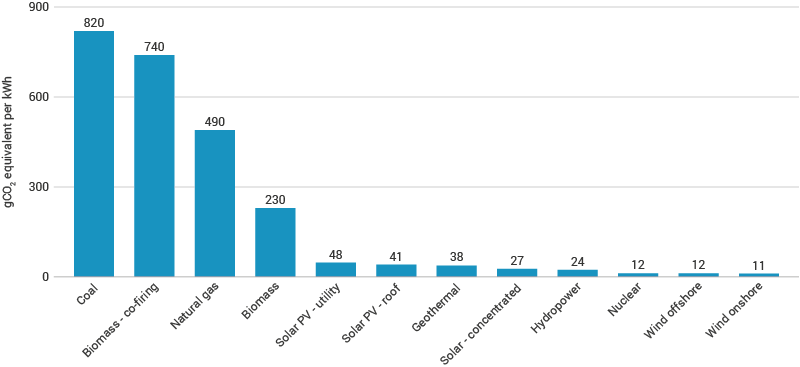
When discussing the carbon footprint of coal energy, we must take into account carbon emissions across the energy’s building, operating, and building back phases.
| The life-cycle stages of coal energy | Each stage’s carbon footprint |
| Building of coal energy | Mining, construction, and transportation |
| Operating of coal energy | Operation of the coal power plant |
| Building back of coal energy | Shutdown, decommissioning, remediation, and redevelopment |
The world collectively emitted 13.98 billion tons of CO2 from coal in 2020, higher than that from all other industries.
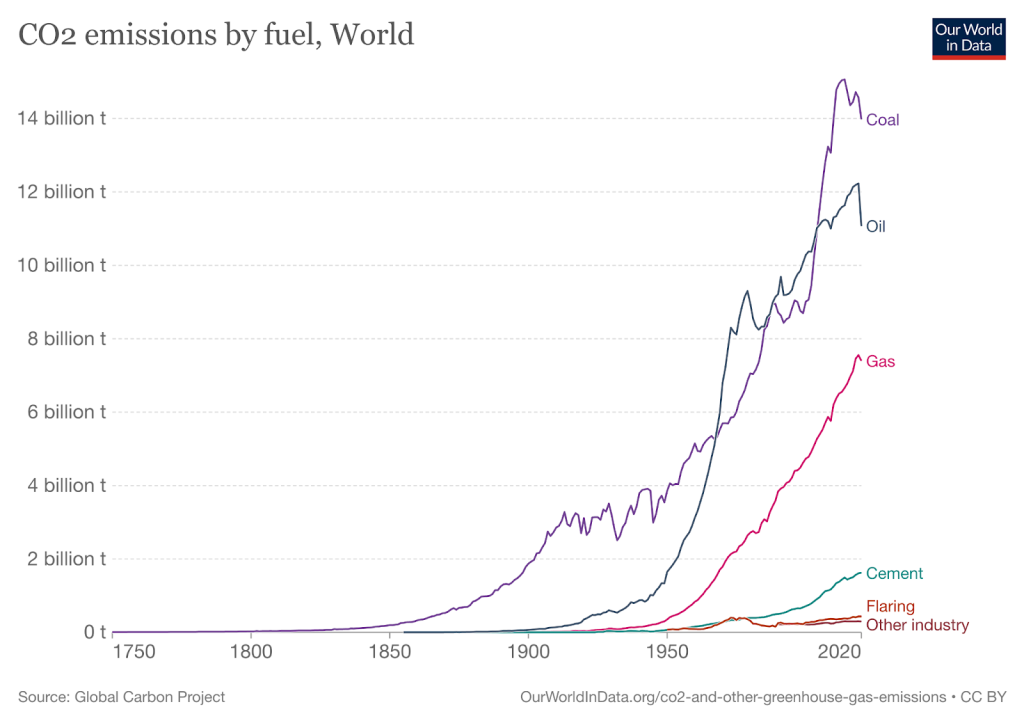
1 ton of coal creates 2.086 tons (4,172 lbs) of CO2 when it is burned. This number varies based on the type of coal that is being burned. Because coal consumption makes up a large part of our electricity generation and emits so much carbon, it is important to understand what its carbon footprint is and how its carbon emissions affect the global climate change process.
How Environmentally Friendly Is Coal Energy
Coal is the world’s most abundant and cheapest fossil fuel source, but the combustion of coal produces over nearly 14 billion tons of CO2 emissions every year, which contributes significantly to global climate change.
“Environmentally friendly: (of products) not harming the environment.”
Cambridge Dictionary
Coal is considered a dirty fuel source because of its high rate of CO2 emissions, toxic heavy metals, and other chemicals that contribute to global climate change. Because of this, the environmental benefits are scarce, and the environmental drawbacks are abundant.
What Are The Environmental Benefits of Coal Energy
Although coal does not benefit the environment, there are ways to possibly mitigate its environmental impact. Various methods to do so include:
- Desulfurization: Equipment known as flue gas desulfurization (FGD) scrubbers are installed in smokestacks to remove sulfur dioxide (SO2) emissions before they enter the atmosphere. The coal industry has also made strides in the development of technology that can remove impurities from coal, making coal more energy-efficient.
- Carbon capture: Separating CO2 from coal emissions and recovering it in a concentrated stream for later injection underground (sequestration). This method is difficult, expensive, would increase the fuel needs of a power plant, and would likely double the price of electricity.
- Re-use and recycling: Reducing the environmental effects of coal production and use by reclaiming land used for coal mining and repurposing it as airports, landfills, and golf courses. Waste emissions captured by scrubbers can be used in the production of products such as cement and synthetic gypsum for wallboard.
Burning coal without adding to atmospheric CO2 levels and releasing toxic materials is a major challenge. There are ways to reduce the environmental impact, but they are often expensive and difficult to implement.
What Are The Environmental Drawbacks of Coal Energy
The main disadvantage of coal energy is its significant contribution to climate change and global warming.
- Atmospheric CO2: Levels of CO2 in our atmosphere have increased as a result of human emissions since the beginning of the Industrial Revolution in 1750. Emissions increased steadily to 5 billion tons per year in the mid-20th century before increasing exponentially to more than 35 billion tons per year at the end of the 20th century. The global average amount of CO2 in the atmosphere was about 280 parts per million (ppm) in 1750 but today registers at over 400 ppm. By the end of the 21st century, this number is expected to exceed 900 ppm. Burning coal adds to this total, which in turn amplifies the greenhouse effect and causes global warming.
- Global warming: This phenomenon occurs when CO2 and other air pollutants absorb sunlight and solar radiation in the atmosphere, trapping the heat and acting as an insulator for the planet. Since the Industrial Revolution, Earth’s temperature has risen a little more than 1 degree Celsius (C), or 2 degrees Fahrenheit (F). Between 1880-1980 the global temperature rose by 0.07C every 10 years. This rate has more than doubled since 1981, with a current global annual temperature rise of 0.18C, or 0.32F, for every 10 years. Experts claim that to avoid a future plagued by rising sea levels, acidified oceans, loss of biodiversity, more frequent and severe weather events, and other environmental disasters brought on by the hotter temperatures, we must limit global warming to 1.5C by 2040.
Other environmental drawbacks include:
- Air pollution: Burning coal releases numerous pollutants including mercury, lead, sulfur dioxide, nitrogen oxides, particulates, and other heavy metals. These cause numerous health problems including asthma, breathing difficulties, brain damage, heart problems, cancer, neurological disorders, and premature death. The US EPA does set pollutant limits, but many plants do not possess the necessary pollution control installed.
- Water pollution: A byproduct of coal energy production is the leftover coal ash residue that contaminates ponds, lakes, landfills, and other sites that could eventually lead to the contamination of waterways and drinking water supplies. Another concern is acid rock drainage from coal mines, the destruction of mountaintop streams and valleys by mountaintop removal mining, and the reliance of coal plants on local water supplies.
- Waste products: Coal contains large amounts of toxic heavy metals and chemicals that, if not contained properly in reservoirs, can leach into surface and groundwater supplies and cause problems such as cancer, birth defects, reproductive disorders, neurological damage, learning disabilities, and kidney disease.
The easiest way to mitigate the environmental impact of coal is to simply not rely on it in the first place. Coal-burning power plants release toxic chemicals and heavy metals, produce coal ash, and contribute directly to global warming.
How Does Coal Energy Contribute to Climate Change
Coal has powered our businesses, cars, and lights for over a century. But when burned it release large amounts of carbon and other GHGs, which directly contribute to climate change.
Climate change is arguably the most severe, long-term, global impact of fossil fuel combustion. Every year, approximately 33 bt of CO2 are emitted from burning fossil fuels. 44% (14.5 bt) of this comes from coal. The stored carbon found in coal reacts with oxygen in the air to produce CO2.
CO2 emissions contribute to climate change in the following ways:
- Increasing temperatures: Earth’s atmosphere has warmed 1.5℃ since 1880. This may not seem like a lot, but these degrees create regional and seasonal temperature extremes, reduce sea ice, intensify rainfall and drought severity, and change habitat ranges for plants and animals.
- Rising sea levels: Global sea levels have increased approximately 8-9 inches since 1880, displacing people living along coastlines and destroying coastal habitats. Roads, bridges, subways, water supplies, oil and gas wells, power plants, sewage treatment plants, and landfills remain at risk if sea level rise goes unchecked.
- Melting of sea ice: Since 1979 arctic sea ice has declined by 30%. Sea ice plays a major role in regulating the earth’s climate by reflecting sunlight into space and providing habitat for animal species. If all of the glaciers on Earth melted, sea levels would rise by approximately 70 feet, effectively flooding out every coastal city on the planet.
- Changing precipitation patterns: Extreme weather events (e.g., hurricanes, floods, droughts) are becoming more common and more intense. Storm-affected areas will experience increased precipitation and flooding whereas areas located further from storm tracks will experience decreased precipitation and droughts.
- Ocean acidification: The ocean absorbs 30% of the CO2 released into the atmosphere, which decreases the pH (increases the acidity) of the ocean. In the past 200 years, the pH of oceans has decreased by 0.1 pH units, which translates to a 30% increase in acidity. Aquatic life unable to adjust to this rapid acidification will die off. A prime example of this is coral bleaching, where coral expel the algae (zooxanthellae) living in their tissues as a result of changes in temperature, light, or nutrients.
The more we reduce CO2 emissions, the more we slow the rate of temperature rise, sea-level rise, ice melting, and ocean acidification. When these rates are slowed, the earth’s biodiversity does not have to struggle to adapt to temperature and pH changes. People will not be displaced due to the flooding of coastal areas. And icebergs will continue to provide climate regulation.
To help keep global temperature rise below 1.5C, as outlined in the Paris Agreement, we must shift at least 80% of our electricity generation to low carbon sources. To become net zero by 2050, we must also shut down 870 GW of coal capacity globally, or approximately 11% of all coal power capacity.
Final Thoughts
Coal energy is produced when the ancient remains of pressurized plants and animals (i.e. coal) is combusted in coal-fired power plants. The process creates steam which turns a turbine and spins a generator to produce electricity. We have relied on coal as a main source of energy for decades, but if we continue to use this finite resource at current rates we can expect to deplete it in approximately 100 years.
Coal is considered a dirty energy because of its high level of CO2 emissions when combusted and its ability to pollute our atmosphere, land, and water. It directly contributes to and exacerbates climate change. Our health and our planet’s health would be improved if we did not use coal as a source of energy.
Stay impactful,

Sources
- International Energy Agency: Coal – Fuels and Technologies
- US Energy Information Administration: Coal Explained
- Impactful Ninja: Fossil Fuel Energy Explained – All You Need to Know
- National Resources Defense Council: Fossil Fuels – the Dirty Facts
- United States Geological Survey: What are the types of coal?
- American Geosciences Institute: What are the different types of coal?
- McKinsey Sustainability: Climate risk and decarbonization – What every mining CEO needs to know
- United States Geological Survey: A Coal-Fired Thermoelectric Power Plant
- Union of Concerned Scientists: The Hidden Costs of Fossil Fuels
- World Coal Association: Coal and Electricity
- Nature: Quantifying operational lifetimes for coal power plants under the Paris goals
- APSense: How a Coal-Fired Power Plant Works
- Our World in Data: CO2 emissions by fuel
- Statista: Distribution of coal production worldwide in 2021, by major countries
- Statista: Number of operational coal power plants worldwide as of January 2022, by country/territory
- International Energy Agency: Coal 2021 – Analysis and forecast to 2024
- Our World in Data: Fossil Fuels
- International Energy Agency: Demand – Coal Market Update – July 2022
- MET Group: When Will Fossil Fuels Run Out?
- Britannica: Carbon Footprint
- United States Environmental Protection Agency: System of Registries
- Forbes: Global Coal Consumption Surged In 2021
- World Nuclear Association: Carbon Emissions from Electricity
- Freeing Energy: How much CO2 and pollution comes from burning coal?
- Impactful Ninja: What Is the Carbon Footprint of Coal Energy?
- US Energy Information Administration: Coal and the Environment
- US Energy Information Administration: Coal plants without scrubbers account for a majority of U.S. SO2 emissions
- World Nuclear Association: ‘Clean Coal’ Technologies, Carbon Capture & Sequestration
- National Oceanic and Atmospheric Administration: Climate Change – Atmospheric Carbon Dioxide
- Union of Concerned Scientists: Coal Power Impact
- National Resources Defense Council: Global Warming 101
- The National Wildlife Federation: Climate Change
- National Oceanic and Atmospheric Administration: Climate Change – Global Temperature
- National Oceanic and Atmospheric Administration: Climate Change – Global Sea Level
- United States Geological Survey: How would sea level change if all glaciers melted?
- National Aeronautics and Space Administration, U.S.A.: How does climate change affect precipitation?
- National Oceanic and Atmospheric Administration: Ocean Acidification
- National Ocean Service: What is coral bleaching?
- United Nations Framework Convention on Climate Change: The Paris Agreement
- International Energy Agency: Coal-Fired Power – Analysis
